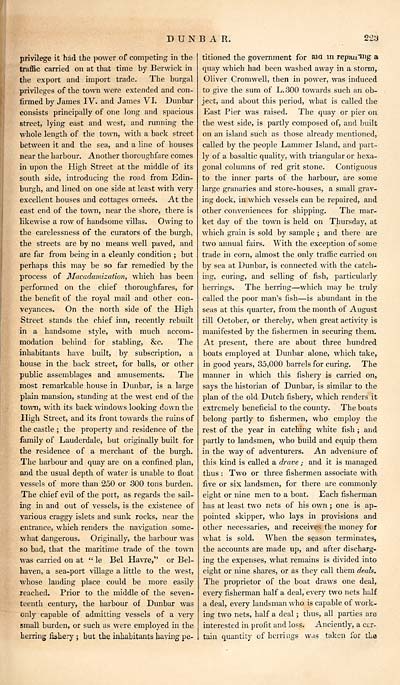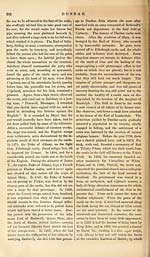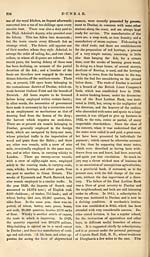Gazetteer of Scotland > Volume 1
(253) Page 223
Download files
Complete book:
Individual page:
Thumbnail gallery: Grid view | List view

DUNBAR.
223
privilege it had the power of competing in the
traffic carried on at that time by Berwick in
the export and import trade. The burgal
privileges of the town were extended and con-
firmed by James IV. and James VI. Dunbar
consists principally of one long and spacious
street, lying east and west, and running the
whole length of the town, with a back street
between it and the sea, and a line of houses
near the harbour. Another thoroughfare comes
in upon the High Street at the middle of its
south side, introducing the road from Edin-
burgh, and lined on one side at least with very
excellent houses and cottages ornees. At the
east end of the town, near the shore, there is
likewise a row of handsome villas. Owing to
the carelessness of the curators of the burgh,
the streets are by no means well paved, and
are far from being in a cleanly condition ; but
perhaps this may be so far remedied by the
process of Macadamization, which has been
performed on the chief thoroughfares, for
the benefit of the royal mail and other con-
veyances. On the north side of the High
Street stands the chief inn, recently rebuilt
in a handsome style, with much accom-
modation behind for stabling, &c. The
inhabitants have built, by subscription, a
house in the back street, for balls, or other
public assemblages and amusements. The
most remarkable house in Dunbar, is a large
plain mansion, standing at the west end of the
town, with its back windows looking down the
High Street, and its front towards the ruins of
the castle ; the property and residence of the
family of Lauderdale, but originally built for
the residence of a merchant of the burgh.
The harbour and quay are on a confined plan,
and the usual depth of water is unable to float
vessels of more than 250 or 300 tons burden.
The chief evil of the port, as regards the sail-
big in and out of vessels, is the existence of
various craggy islets and sunk rocks, near the
entrance, which renders the navigation some-
what dangerous. Originally, the harbour was
so bad, that the maritime trade of the town
was carried on at " le Bel Havre," or Bel-
haven, a sea-port village a little to the west,
whose landing place could be more easily
reached. Prior to the middle of the seven-
teenth century, the harbour of Dunbar was
only capable of admitting vessels of a very
small burden, or such as were employed in the
herring fishery ; but the inhabitants having pe-
titioned the government for aid in repauing a
quay which had been washed away in a storm,
Oliver Cromwell, then in power, was induced
to give the sum of L.300 towards such an ob-
ject, and about this period, what is called the
East Pier was raised. The quay or pier on
the west side, is partly composed of, and built
on an island such as those already mentioned,
called by the people Lammer Island, and part-
ly of a basaltic quality, with triangular or hexa-
gonal columns of red grit stone. Contiguous
to the inner parts of the harbour, are some
large granaries and store-houses, a small grav-
ing dock, in which vessels can be repaired, and
other conveniences for shipping. The mar-
ket day of the town is held on Thursday, at
which grain is sold by sample ; and there are
two annual fairs. With the exception of some
trade in corn, almost the only traffic carried on
by sea at Dunbar, is connected with the catch-
ing, curing, and selling of fish, particularly
herrings. The herring — which may be truly
called the poor man's fish — is abundant in the
seas at this quarter, from the month of August
till October, or thereby, when great activity is
manifested by the fishermen in securing them.
At present, there are about three hundred
boats employed at Dunbar alone, which take,
in good years, 35,000 barrels for curing. The
manner in which this fishery is carried on,
says the historian of Dunbar, is similar to the
plan of the old Dutch fishery, which renders it
extremely beneficial to the county. The boats
belong partly to fishermen, who employ the
rest of the year in catching white fish ; and
partly to landsmen, who build and equip them
in the way of adventurers. An adventure of
this kind is called a drave ; and it is managed
thus : Two or three fishermen associate with
five or six landsmen, for there are commonly
eight or nine men to a boat. Each fisherman
has at least two nets of his own ; one is ap-
pointed skipper, who lays in provisions and
other necessaries, and receives the money for
what is sold. When the season terminates,
the accounts are made up, and after discharg-
ing the expenses, what remains is divided into
eight or nine shares, or as they call them deals.
The proprietor of the boat draws one deal,
every fisherman half a deal, every two nets half
a deal, every landsman who is capable of work-
ing two nets, half a deal ; thus, all parties are
interested in profit and loss. Anciently, a cer-
tain quantity of herrings was taken for the
223
privilege it had the power of competing in the
traffic carried on at that time by Berwick in
the export and import trade. The burgal
privileges of the town were extended and con-
firmed by James IV. and James VI. Dunbar
consists principally of one long and spacious
street, lying east and west, and running the
whole length of the town, with a back street
between it and the sea, and a line of houses
near the harbour. Another thoroughfare comes
in upon the High Street at the middle of its
south side, introducing the road from Edin-
burgh, and lined on one side at least with very
excellent houses and cottages ornees. At the
east end of the town, near the shore, there is
likewise a row of handsome villas. Owing to
the carelessness of the curators of the burgh,
the streets are by no means well paved, and
are far from being in a cleanly condition ; but
perhaps this may be so far remedied by the
process of Macadamization, which has been
performed on the chief thoroughfares, for
the benefit of the royal mail and other con-
veyances. On the north side of the High
Street stands the chief inn, recently rebuilt
in a handsome style, with much accom-
modation behind for stabling, &c. The
inhabitants have built, by subscription, a
house in the back street, for balls, or other
public assemblages and amusements. The
most remarkable house in Dunbar, is a large
plain mansion, standing at the west end of the
town, with its back windows looking down the
High Street, and its front towards the ruins of
the castle ; the property and residence of the
family of Lauderdale, but originally built for
the residence of a merchant of the burgh.
The harbour and quay are on a confined plan,
and the usual depth of water is unable to float
vessels of more than 250 or 300 tons burden.
The chief evil of the port, as regards the sail-
big in and out of vessels, is the existence of
various craggy islets and sunk rocks, near the
entrance, which renders the navigation some-
what dangerous. Originally, the harbour was
so bad, that the maritime trade of the town
was carried on at " le Bel Havre," or Bel-
haven, a sea-port village a little to the west,
whose landing place could be more easily
reached. Prior to the middle of the seven-
teenth century, the harbour of Dunbar was
only capable of admitting vessels of a very
small burden, or such as were employed in the
herring fishery ; but the inhabitants having pe-
titioned the government for aid in repauing a
quay which had been washed away in a storm,
Oliver Cromwell, then in power, was induced
to give the sum of L.300 towards such an ob-
ject, and about this period, what is called the
East Pier was raised. The quay or pier on
the west side, is partly composed of, and built
on an island such as those already mentioned,
called by the people Lammer Island, and part-
ly of a basaltic quality, with triangular or hexa-
gonal columns of red grit stone. Contiguous
to the inner parts of the harbour, are some
large granaries and store-houses, a small grav-
ing dock, in which vessels can be repaired, and
other conveniences for shipping. The mar-
ket day of the town is held on Thursday, at
which grain is sold by sample ; and there are
two annual fairs. With the exception of some
trade in corn, almost the only traffic carried on
by sea at Dunbar, is connected with the catch-
ing, curing, and selling of fish, particularly
herrings. The herring — which may be truly
called the poor man's fish — is abundant in the
seas at this quarter, from the month of August
till October, or thereby, when great activity is
manifested by the fishermen in securing them.
At present, there are about three hundred
boats employed at Dunbar alone, which take,
in good years, 35,000 barrels for curing. The
manner in which this fishery is carried on,
says the historian of Dunbar, is similar to the
plan of the old Dutch fishery, which renders it
extremely beneficial to the county. The boats
belong partly to fishermen, who employ the
rest of the year in catching white fish ; and
partly to landsmen, who build and equip them
in the way of adventurers. An adventure of
this kind is called a drave ; and it is managed
thus : Two or three fishermen associate with
five or six landsmen, for there are commonly
eight or nine men to a boat. Each fisherman
has at least two nets of his own ; one is ap-
pointed skipper, who lays in provisions and
other necessaries, and receives the money for
what is sold. When the season terminates,
the accounts are made up, and after discharg-
ing the expenses, what remains is divided into
eight or nine shares, or as they call them deals.
The proprietor of the boat draws one deal,
every fisherman half a deal, every two nets half
a deal, every landsman who is capable of work-
ing two nets, half a deal ; thus, all parties are
interested in profit and loss. Anciently, a cer-
tain quantity of herrings was taken for the
Set display mode to: Large image | Transcription
Images and transcriptions on this page, including medium image downloads, may be used under the Creative Commons Attribution 4.0 International Licence unless otherwise stated. ![]()
| Gazetteers of Scotland, 1803-1901 > Gazetteer of Scotland > Volume 1 > (253) Page 223 |
|---|
| Permanent URL | https://digital.nls.uk/97427398 |
|---|
| Description | Volume I: Abbey to Glenartney. |
|---|---|
| Attribution and copyright: |
|
| Description | By Robert Chambers and William Chambers. Glasgow: Blackie & Son, 1838. 2 volumes. |
|---|---|
| Shelfmark | NF.1461.g.7 |
| Additional NLS resources: | |

